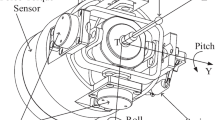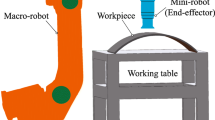Abstract
For robotic polishing of curved surfaces with compliant polishing disc, it is critical to accurately control the tilt angle of the polishing disc and normal contact force between the disc and the workpiece surface simultaneously. As conventional industrial robots lack force control capability, a 3-DOF two-rotational-one-translational (2R1T) force-controlled end-effector based on the 3-PPS parallel mechanism is developed for robotic polishing. During the polishing process, the changes of the tilt angle of the end-effector’s moving platform will result in displacement variations of the contact point, owing to the inherent parasitic motion of the end-effector module, the geometry of the disc, and the compliance of the disc. Without proper compensation of the displacement variation, the control accuracy of contact force will be significantly decreased. To tackle this problem, a parametric model is established to predict the contact point variation. A hybrid orientation/force control architecture with compensation of the contact point variation is proposed. Based on the kinematic analysis, orientation control is achieved through a position controller. The force tracking control considering the uncertainty of the environment is achieved through an admittance controller. By introducing the contact point compensation model into the control architecture, the control accuracy of the contact force is significantly improved. The proposed control architecture is evaluated on a macro-mini manipulator consisting of a 6-DOF industrial robot and the 2R1T force-controlled end-effector. The experimental results indicate that the orientation control is accurate and the mean force errors with three different kinds of tilt angle references are reduced by 78.9\(\%\), 81.1\(\%\) and 72.3\(\%\) compared to the conventional hybrid orientation/force control, respectively, which validate the effectiveness of the proposed control method.

















Similar content being viewed by others
Data availability
All allowed data have been provided in the manuscript.
Code availability
Not applicable.
References
Verl A, Valente A, Melkote S, Brecher C, Ozturk E, Tunc LT (2019) Robots in machining. CIRP Ann Manuf Technol 68(2):799–822. https://doi.org/10.1016/j.cirp.2019.05.009
Xiao M, Ding Y, Fang Z, Yang G (2020) Contact force modeling and analysis for robotic tilted-disc polishing of freeform workpieces. Precis Eng 66:188–200. https://doi.org/10.1016/j.precisioneng.2020.04.019
Zhu WL, Beaucamp A (2020) Compliant grinding and polishing: A review. Int J Mach Tools Manuf 158:103634. https://doi.org/10.1016/j.ijmachtools.2020.103634
Wang QH, Liang YJ, Xu CY, Li JR, Zhou XF (2019) Generation of material removal map for freeform surface polishing with tilted polishing disk. Int J Adv Manuf Technol 102(9):4213–4226. https://doi.org/10.1007/s00170-019-03478-8
Mason MT (1981) Compliance and force control for computer controlled manipulators. IEEE Trans Syst Man Cybern Syst 11(6):418–432. https://doi.org/10.1109/TSMC.1981.4308708
Raibert MH, Craig JJ (1981) Hybrid position/force control of manipulators. J Dyn Syst, Meas, Control 103(2):126–133. https://doi.org/10.1115/1.3139652
Dong J, Shi J, Liu C, Yu T (2021) Research of pneumatic polishing force control system based on high speed on/off with pwm controlling. Robot Comput-Integr Manuf 70:102133. https://doi.org/10.1016/j.rcim.2021.102133
Mohammad AEK, Hong J, Wang D, Guan Y (2019) Synergistic integrated design of an electrochemical mechanical polishing end-effector for robotic polishing applications. Robot Comput-Integr Manuf 55:65–75. https://doi.org/10.1016/j.rcim.2018.07.005
Wang Q, Wang W, Zheng L, Yun C (2021) Force control-based vibration suppression in robotic grinding of large thin-wall shells. Robot Comput-Integr Manuf 67:102031. https://doi.org/10.1016/j.rcim.2020.102031
Oba Y, Kakinuma Y (2017) Simultaneous tool posture and polishing force control of unknown curved surface using serial-parallel mechanism polishing machine. Precis Eng 49:24–32. https://doi.org/10.1016/j.precisioneng.2017.01.006
Cazalilla J, Vallés M, Ángel Valera, Mata V, Díaz-Rodríguez M (2016) Hybrid force/position control for a 3-dof 1t2r parallel robot: Implementation, simulations and experiments. Mech Based Des Struct Mech 44(1–2):16–31. https://doi.org/10.1080/15397734.2015.1030679
Solanes JE, Gracia L, Muñoz-Benavent P, Valls Miro J, Perez-Vidal C, Tornero J (2018) Robust Hybrid Position-Force Control for Robotic Surface Polishing. J Manuf Sci Eng 141(1). https://doi.org/10.1115/1.4041836
Navvabi H, Markazi AHD (2019) Hybrid position/force control of Stewart Manipulator using Extended Adaptive Fuzzy Sliding Mode Controller (E-AFSMC). ISA Trans 88:280–295. https://doi.org/10.1016/j.isatra.2018.11.037
Akdoǧan E, Aktan ME, Koru AT, Selçuk Arslan M, Atlihan M, Kuran B (2018) Hybrid impedance control of a robot manipulator for wrist and forearm rehabilitation: Performance analysis and clinical results. Mechatronics 49:77–91. https://doi.org/10.1016/j.mechatronics.2017.12.001
Cao H, He Y, Chen X, Zhao X (2020) Smooth adaptive hybrid impedance control for robotic contact force tracking in dynamic environments. Ind Robot 47(2):231–242. https://doi.org/10.1108/IR-09-2019-0191
Hosseinzadeh M, Aghabalaie P, Talebi HA, Shafie M (2010) Adaptive hybrid impedance control of robotic manipulators. In: IECON 2010 - 36th Annual Conference on IEEE Industrial Electronics Society, pp 1442–1446. https://doi.org/10.1109/IECON.2010.5675472
Calanca A, Muradore R, Fiorini P (2016) A review of algorithms for compliant control of stiff and fixed-compliance robots. IEEE-ASME Trans Mechatron 21(2):613–624. https://doi.org/10.1109/TMECH.2015.2465849
Hogan N (1985) Impedance control: An approach to manipulation: Part i-theory. J Dyn Syst Meas Control 107(1):1–7. https://doi.org/10.1115/1.3140702
Seraji H, Colbaugh R (1997) Force tracking in impedance control. Int J Rob Res 16(1):97–117. https://doi.org/10.1177/027836499701600107
Jung S, Hsia TC, Bonitz RG (2001) Force tracking impedance control for robot manipulators with an unknown environment: Theory, simulation, and experiment. Int J Rob Res 20(9):765–774. https://doi.org/10.1177/02783640122067651
Yang G, Zhu R, Fang Z, Chen C, Zhang C (2020) Kinematic design of a 2r1t robotic end-effector with flexure joints. IEEE Access 8:57204–57213. https://doi.org/10.1109/ACCESS.2020.2982185
Funding
This work was supported by the National Key Research and Development Program of China (2018YFB1308900), the National Natural Science Foundation of China (92048201, U1909215, 52127803, U1813223), the Equipment Development Project of CAS (YJKYYQ20200030), the Ningbo Key Project of Scientific and Technological Innovation 2025 (2018B10058).
Author information
Authors and Affiliations
Contributions
Renfeng Zhu: conceptualization, writing original draft, validation; Guilin Yang: resources, instructing, review; Zaojun Fang: instructing, review; Junjie Dai: validation; Chin-Yin Chen: instructing, review; Guolong Zhang: review; Chi Zhang: instructing, review; All authors read and approved the final manuscript.
Corresponding authors
Ethics declarations
Ethics approval
Not applicable.
Consent to participate
Not applicable.
Consent for publication
Not applicable.
Competing interests
The authors declare no competing interests.
Additional information
Publisher’s Note
Springer Nature remains neutral with regard to jurisdictional claims in published maps and institutional affiliations.
Rights and permissions
About this article
Cite this article
Zhu, R., Yang, G., Fang, Z. et al. Hybrid orientation/force control for robotic polishing with a 2R1T force-controlled end-effector. Int J Adv Manuf Technol 121, 2279–2290 (2022). https://doi.org/10.1007/s00170-022-09407-6
Received:
Accepted:
Published:
Issue Date:
DOI: https://doi.org/10.1007/s00170-022-09407-6




